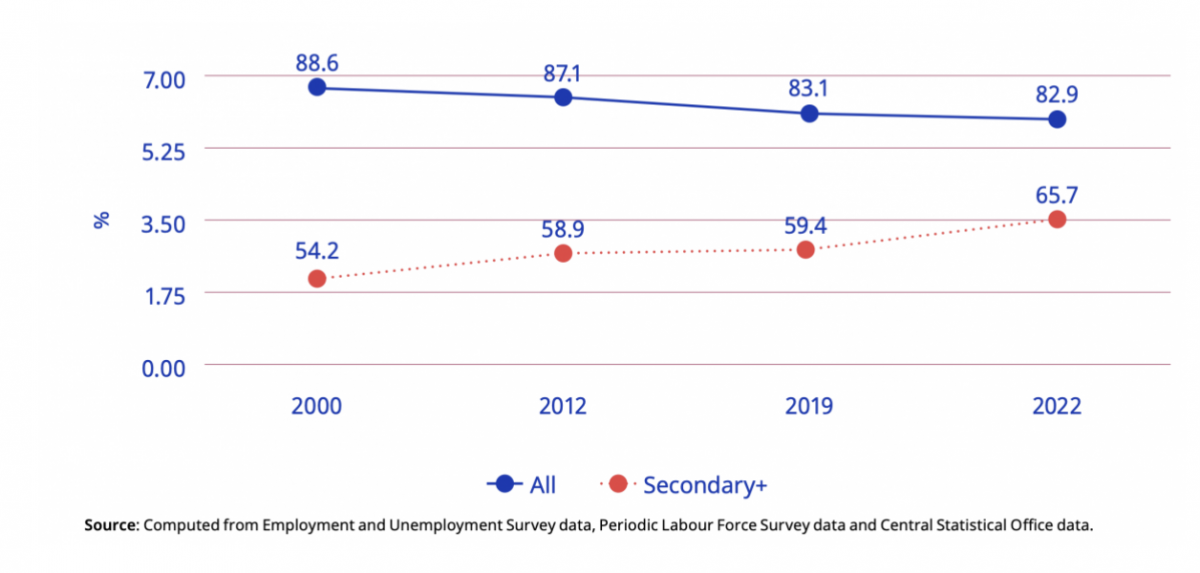Fact Checking Modi’s Claim That His Jobs ‘Track Record Compared to Previous Governments is the Best’
New Delhi: What Modi says: Prime Minister Narendra Modi in an interview to news agency PTI published on May 20 on unemployment, “Our track record in creating more and more opportunities for our youth as compared to previous governments has been the best.”
What people think: A Lokniti-CSDS survey has pointed out that the people surveyed are most concerned about unemployment and price rise. Their material well-being is severely impacted, which is a matter of concern to them. In response to the question, “If you compare today with the last five years, do you think it is much easier to get jobs or has it become more difficult?” 62% said it was more difficult.
What the jobs graph (over time, i.e., versus ‘previous governments’) says:

What the facts are:
1. Unemployment rate in India rose to 8% in 2023-24
Unemployment rate among persons aged 15 years and above, rose to 8% in the fiscal year 2023-24 from 7.5-7.7% in the preceding two years, according to the Centre for Monitoring Indian Economy (CMIE).
The number of unemployed persons actively looking for employment has touched nearly 37 million, according to CMIE data. Over the past seven years, the unemployment rate went beyond 8%, during the pandemic in 2020-21.
Labour force participation
Additionally, the labour participation rate, a key indicator of the labour market’s health, appears to be struggling to recover to its pre-pandemic levels.
India’s LPR in 2016-17 stood at 46.2%. The metric fell to about 42-44% in the subsequent three years.
Also read: Some Proof Required: Modi Government’s Abysmal Record of No Jobs
It dropped to below 40% in 2020-21, and has remained impaired since. At 40.4%, India’s LPR in 2023-24 was about 5.8 percentage points lower than in 2016-17.
2. Unemployment in India touched a 45-year high in 2019
In 2019, as per data released by Labour Ministry the unemployment rate in 2017-18 was 6.1%. This corroborated the pre-2019 general election report that had claimed joblessness at a 45-year high. That was something the Modi government had withheld and that had led to resignation of two officials, in protest.
The report though managed to find its way into the news. leaked report on periodic labour force survey (PLFS) from July 2017 to June 2018 had on comparison with previous surveys concluded that the joblessness was at the highest level in 45 years.
3. Youth unemployment rate in India was higher than of South Asian neighbours
A World Bank report found that in 2022, India's youth unemployment rate was significantly higher at 23.22% than Pakistan (11.3%), Bangladesh (12.9%), and Bhutan (14.4%). In the same year, China had an unemployment rate of 13.2%.

4. Amongst those unemployed are a record number of youth
In 2022, the share of unemployed youths in the total unemployed population was 82.9%. An ILO report, India Employment Report 2024: Youth employment, education and skills underlines that the problem of unemployment in India has become increasingly concentrated among the youth, especially educated youths and women in urban areas.
The share of educated youths among all unemployed people increased 11.5% from 54.2% in 2000 to 65.7% in 2022. Among the educated (secondary level or higher) unemployed youths, women accounted for a larger share (76.7%) than men (62.2%).
Also read: Skill India Mission: Short Courses, No Employable Skills and a Lack of Jobs
5. Record vacancies in central government positions, not opening ‘bharti’ for posts, or opening, then closing them down suddenly is a massive issue
As the Armed forces are seen as a big source of secure and respectful employment, the four-year contract solider scheme, Agniveer is a big downer. Modi not campaigning on it. The Opposition is and has pledged to scrap the scheme if voted to power. Read The Wire, Hindi’s series here. ‘Paper leaks’ have become a massive flashpoint for youth anger and hence a political issue as they relate directly to unemployment.
Nearly 10 lakh posts are vacant across Union government ministries and departments, the government said in an answer to the Lok Sabha during the Monsoon session of Parliament in July, 2023.
In a written response to an unstarred question by the Trinamool Congress (TMC) and the Bharat Rashtra Samithi (BRS) MPs Mala Roy and Nama Nageswara Rao, the Minister of State at the Ministry of Personnel, Public Grievances, and Pensions, and in the Prime Minister’s Office, Jitendra Singh, said that as on March 1, 2023, there were 964,359 vacant posts across government departments.
Jitendra Singh said that these figures are as per the annual report of the Pay Research Units of the Department of Expenditure.
6. IT Sector Jobs Crash
Data from recruitment firm Foundit showed that “online hiring activity for both hardware and software IT plummeted by 18% last year from 2022.”
This article went live on May twenty-first, two thousand twenty four, at forty-five minutes past twelve at noon.The Wire is now on WhatsApp. Follow our channel for sharp analysis and opinions on the latest developments.




